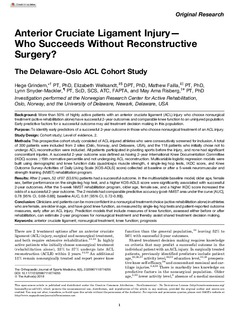| dc.description.abstract | Background: More than 50% of highly active patients with an anterior cruciate ligament (ACL) injury who choose nonsurgical treatment (active rehabilitation alone) have successful 2-year outcomes and comparable knee function to an uninjured population. Early predictive factors for a successful outcome may aid treatment decision making in this population. Purpose: To identify early predictors of a successful 2-year outcome in those who choose nonsurgical treatment of an ACL injury. Study Design: Cohort study; Level of evidence, 2. Methods: This prospective cohort study consisted of ACL-injured athletes who were consecutively screened for inclusion. A total of 300 patients were included from 2 sites (Oslo, Norway, and Delaware, USA), and the 118 patients who initially chose not to undergo ACL reconstruction were included. All patients participated in pivoting sports before the injury, and none had significant concomitant injuries. A successful 2-year outcome was defined as having 2-year International Knee Documentation Committee (IKDC) scores ≥15th normative percentile and not undergoing ACL reconstruction. Multivariable logistic regression models were built using demographic and knee function data (quadriceps muscle strength, 4 single-leg hop tests, IKDC score, and Knee Outcome Survey–Activities of Daily Living Scale [KOS-ADLS] score) collected at baseline or after a 5-week neuromuscular and strength training (NMST) rehabilitation program. Results: After 2 years, 52 of 97 (53.6%) patients had a successful outcome. In the multivariable baseline model, older age, female sex, better performance on the single-leg hop test, and a higher KOS-ADLS score were significantly associated with successful 2-year outcomes. After the 5-week NMST rehabilitation program, older age, female sex, and a higher IKDC score increased the odds of a successful 2-year outcome. The 2 models had comparable predictive accuracy (post-NMST area under the curve [AUC], 0.78 [95% CI, 0.68-0.88]; baseline AUC, 0.81 [95% CI, 0.72-0.89]). Conclusion: Clinicians and patients can be more confident in a nonsurgical treatment choice (active rehabilitation alone) in athletes who are female, are older in age, and have good knee function, as measured by single-leg hop tests and patient-reported outcome measures, early after an ACL injury. Prediction models that include measures of knee function, assessed either before or after rehabilitation, can estimate 2-year prognoses for nonsurgical treatment and thereby assist shared treatment decision making. | nb_NO |
| dc.rights.holder | © The Author(s) 2018. This open-access article is published and distributed under the Creative Commons Attribution - NonCommercial - No Derivatives License (http://creativecommons.org/licenses/by-nc-nd/4.0/), which permits the noncommercial use, distribution, and reproduction of the article in any medium, provided the original author and source are credited. You may not alter, transform, or build upon this article without the permission of the Author(s). | nb_NO |
